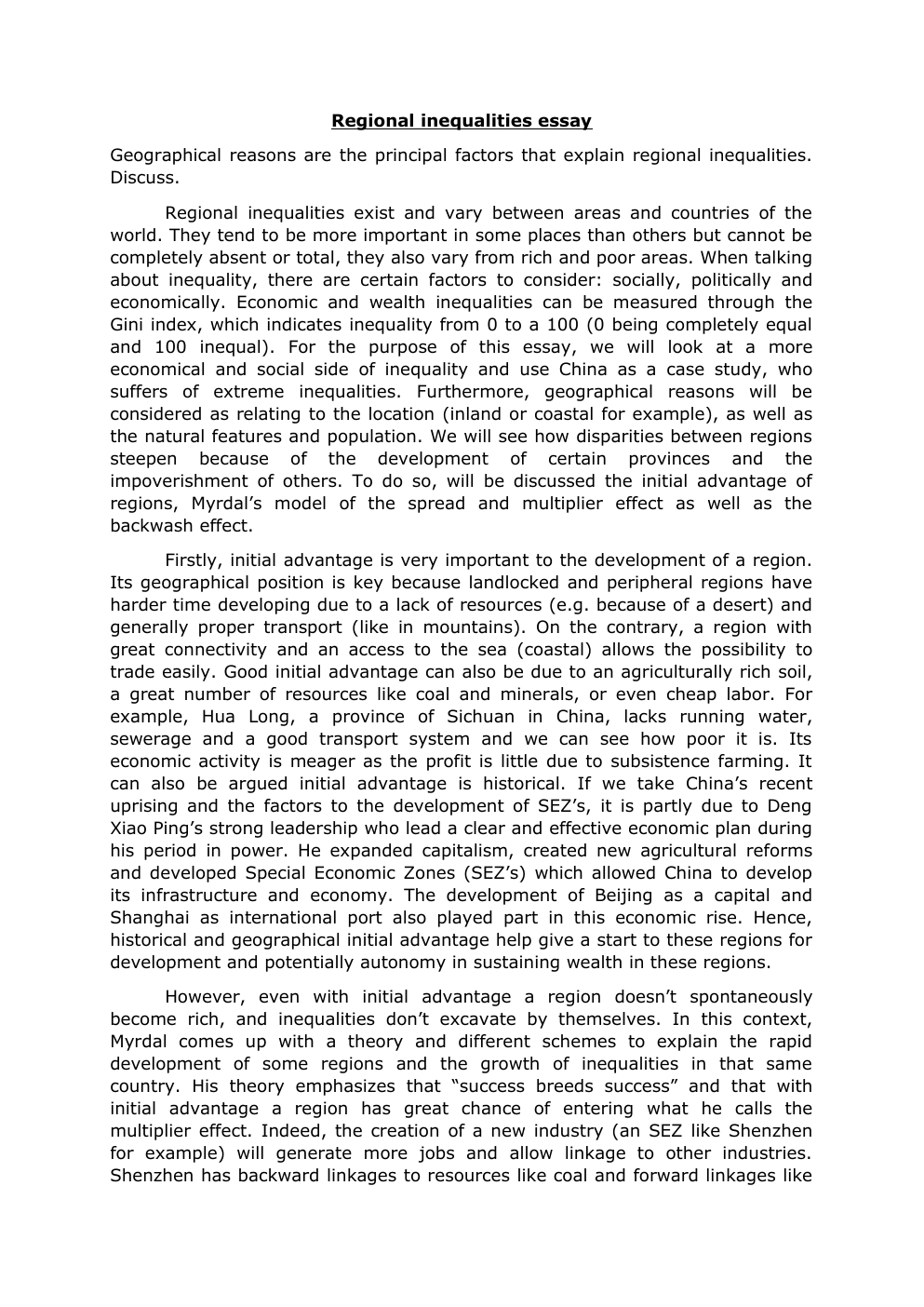regional inequalities oib type essay
Publié le 08/10/2022

Extrait du document
«
Regional inequalities essay
Geographical reasons are the principal factors that explain regional inequalities.
Discuss.
Regional inequalities exist and vary between areas and countries of the
world.
They tend to be more important in some places than others but cannot be
completely absent or total, they also vary from rich and poor areas.
When talking
about inequality, there are certain factors to consider: socially, politically and
economically.
Economic and wealth inequalities can be measured through the
Gini index, which indicates inequality from 0 to a 100 (0 being completely equal
and 100 inequal).
For the purpose of this essay, we will look at a more
economical and social side of inequality and use China as a case study, who
suffers of extreme inequalities.
Furthermore, geographical reasons will be
considered as relating to the location (inland or coastal for example), as well as
the natural features and population.
We will see how disparities between regions
steepen because of the development of certain provinces and the
impoverishment of others.
To do so, will be discussed the initial advantage of
regions, Myrdal’s model of the spread and multiplier effect as well as the
backwash effect.
Firstly, initial advantage is very important to the development of a region.
Its geographical position is key because landlocked and peripheral regions have
harder time developing due to a lack of resources (e.g.
because of a desert) and
generally proper transport (like in mountains).
On the contrary, a region with
great connectivity and an access to the sea (coastal) allows the possibility to
trade easily.
Good initial advantage can also be due to an agriculturally rich soil,
a great number of resources like coal and minerals, or even cheap labor.
For
example, Hua Long, a province of Sichuan in China, lacks running water,
sewerage and a good transport system and we can see how poor it is.
Its
economic activity is meager as the profit is little due to subsistence farming.
It
can also be argued initial advantage is historical.
If we take China’s recent
uprising and the factors to the development of SEZ’s, it is partly due to Deng
Xiao Ping’s strong leadership who lead a clear and effective economic plan during
his period in power.
He expanded capitalism, created new agricultural reforms
and developed Special Economic Zones (SEZ’s) which allowed China to develop
its infrastructure and economy.
The development of Beijing as a capital and
Shanghai as international port also played part in this economic rise.
Hence,
historical and geographical initial advantage help give a start to these regions for
development and potentially autonomy in sustaining wealth in these regions.
However, even with initial advantage a region doesn’t spontaneously
become rich, and inequalities don’t excavate by themselves.
In this context,
Myrdal comes up with a theory and different schemes to explain the rapid
development of some regions and the growth of inequalities in that same
country.
His theory emphasizes that “success breeds success” and that with
initial advantage a region has great chance of entering what he calls the
multiplier effect.
Indeed, the creation of a new industry (an SEZ like Shenzhen
for example) will generate more jobs and allow linkage to other industries.
Shenzhen has backward linkages to resources like coal and forward linkages like
ports to allow trade.
This increases the pool of trained labor causing more
demand for services and migration.
The industry produces....
»
↓↓↓ APERÇU DU DOCUMENT ↓↓↓
Liens utiles
- Essay about "Success" in I Am Charlotte Simmons
- Essay Islam in the UK
- Essay: The Way Up to Heaven
- Correction DS d'histoire-géographie SUJETS DE TYPE COMPARATIF
- I Qu'est-ce que le diabète de type II ?

































